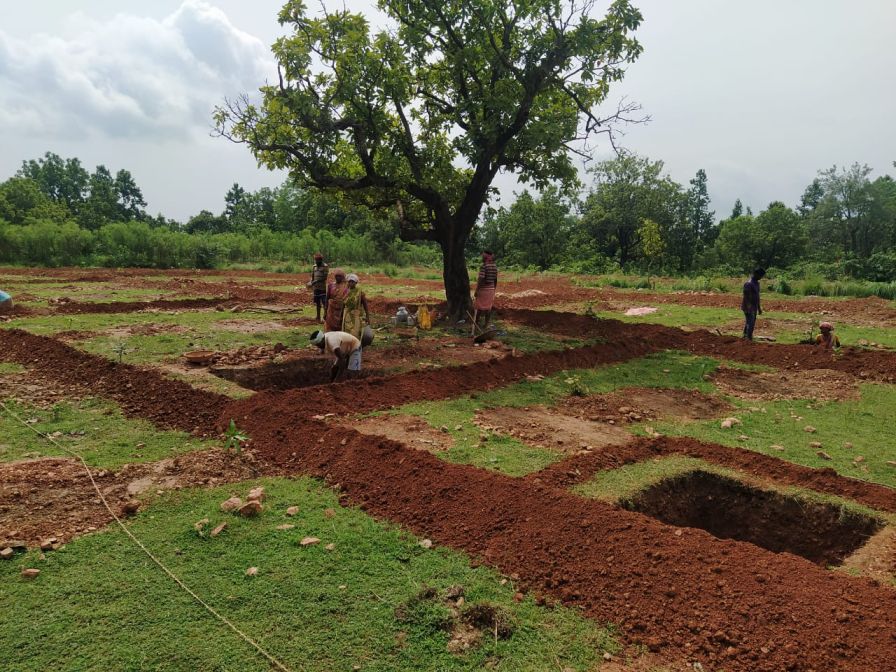The undulating landmass of Jhargram in West Bengal provided its Adivasi inhabitants with the opportunity to grow only one crop i.e. paddy, during the monsoons. For the rest of the year, the locals derive sustenance and nourishment from the forests by cutting and collecting wood, foraging for food, hunting animals, making ropes or doing menial jobs. It has been so for generations but thanks to the intervention of 31-year-old ‘water champion’ Lilabati Mahata, an Adivasi. Due to her efforts, scores of households now grow seasonal vegetables to usher in better times.
An integral part of the Chota Nagpur Plateau, Jhargram became West Bengal’s 22nd district in 2017, having split from Paschim Medinipur and has a particularly severe drought situation. A mere 3 per cent of the population here are urbanites while the rest is rural.
Known as lal-matir desh with its rusty red laterite soil, the sparsely populated Adivasi hamlets have scarce water resources. Though the region receives about 1,400 mm of rainfall between June and September, due to lack of water conservation and irrigation management, the rainwater flows from upland to downstream joining the river resulting in severe water stress and frequent crop failure.
In this water-scarce region, Lilabati, an agricultural labourer of Dhobakhuria village in Binpur 2 block, mobilised hundreds of village women to erect and lay water conservation structures. This has led to the Adivasis taking to growing vegetables, both for consumption and sale. Thanks to her exemplary work the UNDP (United Nations Development Project) in its publication, “A compendium of 41 Women Stewards” has identified Lilabati as a ‘water champion’.
Water-Smart Approach

Married at the age of 16, Lilabati had to abandon her studies after completing her first year in college to take care of her two daughters. The family became farm labourers when her in-laws refused to support them. “We had to find a house of our own. There was no financial security and we led a hand to mouth existence,” she recollects.
In 2011 Lilabati started a self-help savings group (SHG) with women of her neighbourhood and over the next few years it accumulated decent savings. She says, “My husband moved to Tatanagar, having taken up a job and soon started sending part of his salary. I availed of a loan from the SHG in 2016 and leased three bighas in order to grow vegetables. In the four-month period, I earned around Rs 1,20,000. This was enough to make the village folks realise that one could earn from growing one’s food, even if they didn’t own the piece of land.”
Soon womenfolk flocked her leased land in large numbers to learn the techniques she had used and get on-hand experience. Interestingly, even men started seeking her advice. As her popularity grew she helped mobilise the womenfolk to demand the right to work from the Panchayat under the MGNREGA (Mahatma Gandhi National Rural Employment Guarantee Act), which entitles them to 100 days of paid labour in order to build water structures of their choice.
Having earned handsomely from growing vegetables, Lilbati has invested in a Scooty that she rides to reach out to village folks who seek her assistance on crop selection, growing them and water conservation. “We have a WhatsApp Group too. Members address me as ‘didi’, and insist that I visit them on a daily basis, which is not possible. But I am in touch with them regularly to address their queries.”
It was in 2014 that PRADAN (Professional Assistance for Development Action), a non-government, non-profit organisation that works across seven of the poorest states in the country, engaged Lilabati to promote new farming practices amongst the adivasi farmers that were less water-intensive. “I was chosen because I was the most educated in the village. I learnt how to prepare a field before sowing, maintaining soil moisture using mulch, nourishing the soil with vermicompost and most importantly to preserve the groundwater,” elaborates Lilabati.
Since the water levels in her village were declining, the villagers felt the need to build a pond that would store water and allow it to gradually replenish the groundwater table. However, the Panchayat refused to fund the village pond. But the determination of the 500-strong womenfolk and their persistence of two years made the Panchayat ultimately yield and the womenfolk got their pond and adequate compensation for their work too.
This show of courage and endurance motivated the neighbouring villages too, who demanded their right to work from their respective Panchayats.

Lilabati has successfully mobilised her community members to bring rigorous engagement on issues such as soil and moisture conservation and regeneration of natural resources, resource mapping, patch demarcation and problem identification. Through her engagement with the community, she has succeeded in adopting efficient water use in agriculture, which has helped in enhancing practices of agriculture along with better production and strengthening their economic conditions.
So far 1,250 households, spread across 85 villages, having acquired knowledge of various natural resources management, have adopted water conservation methods.
“In the last six years, we have built over 1,000 staggered trenches, contour bunds, filtration pits, seepage tanks, etc., which helps irrigate agriculture plots,” Lilabati says.
The village folk now grow watermelon, brinjal, tomato, chilli, etc., which ensures a decent livelihood. Earlier, they had to take their produce to a market 30km away. Today, traders visit the adivasi villages to collect their produce.
On a concluding note, Lilabati says, “I wish to establish women’s identities as farmers in society through natural resource management.”
(Edited by Yoshita Rao)
No comments:
Post a Comment